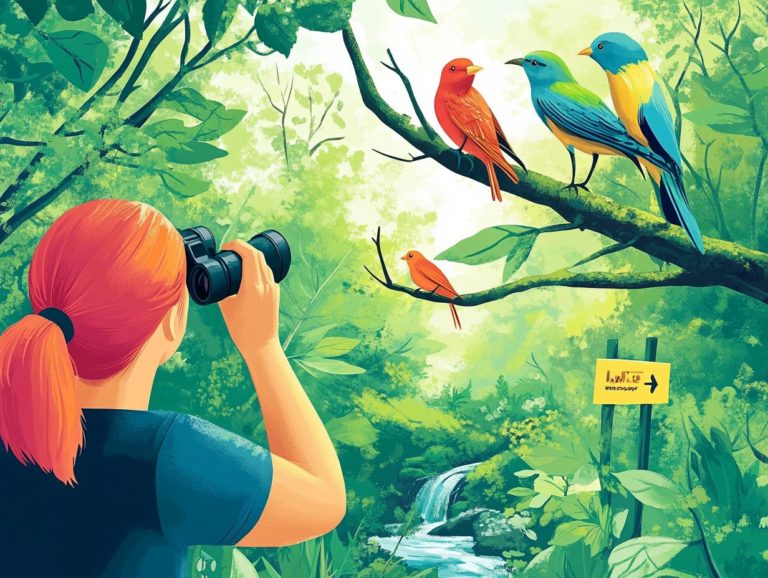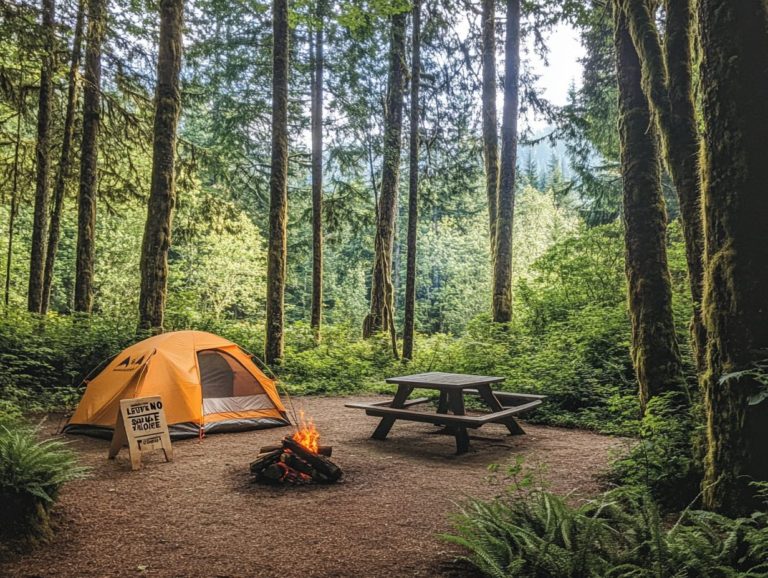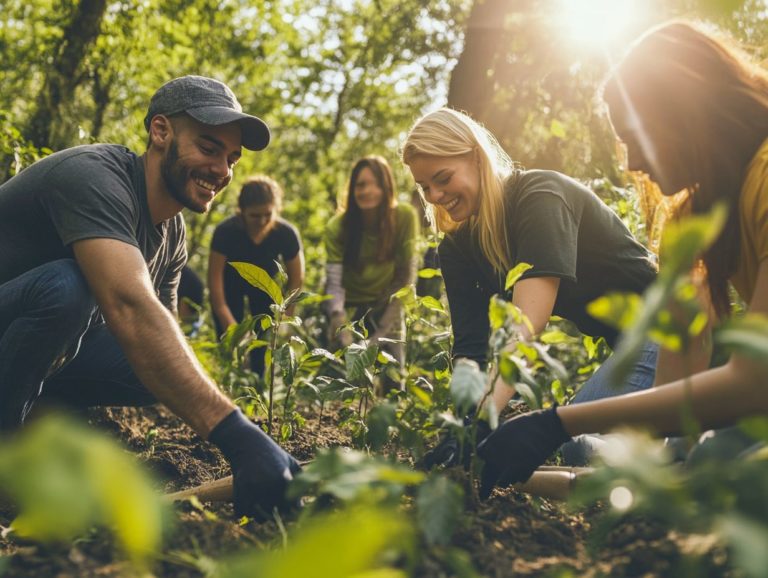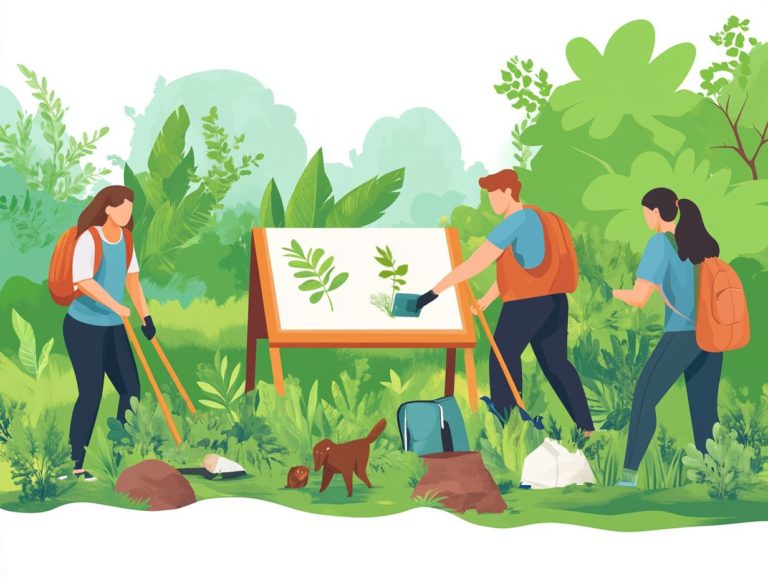5 Activities to Engage Kids in Sustainability
In a world that increasingly prioritizes environmental concerns, teaching kids about sustainability activities has never been more crucial. Engaging young minds through hands-on projects not only fosters a love for the planet but also equips them with the skills to enact meaningful change.
From planting a garden to upcycling old items, this article presents five enjoyable and educational activities designed to inspire children to embrace sustainable practices. You’ll discover the long-term benefits and creative strategies to seamlessly weave sustainability into everyday life. Together, we can nurture the next generation of eco-conscious citizens!
Contents
- Key Takeaways:
- 1. Plant a Garden
- 2. Upcycle Household Items
- 3. Go on a Nature Walk
- 4. Create a Composting System
- 5. Participate in a Beach or Park Cleanup
- Why Is It Important to Teach Kids About Sustainability?
- What Are Some Other Ways to Encourage Sustainable Habits in Kids?
- How Can Parents Incorporate Sustainability into Everyday Activities?
- What Are the Long-Term Benefits of Teaching Kids About Sustainability?
- How Can Schools and Communities Promote Sustainability Education for Kids?
- What Are Some Fun and Creative Ways to Teach Kids About Sustainability?
- Frequently Asked Questions
- What are some fun activities to get kids interested in sustainability?
- How can I teach my kids about conserving energy?
- What are some ways to reduce waste with kids?
- Why is it important to involve kids in sustainability efforts?
- Are there any virtual activities to engage kids in sustainability?
- How can I make sustainability fun and engaging for kids?
Key Takeaways:
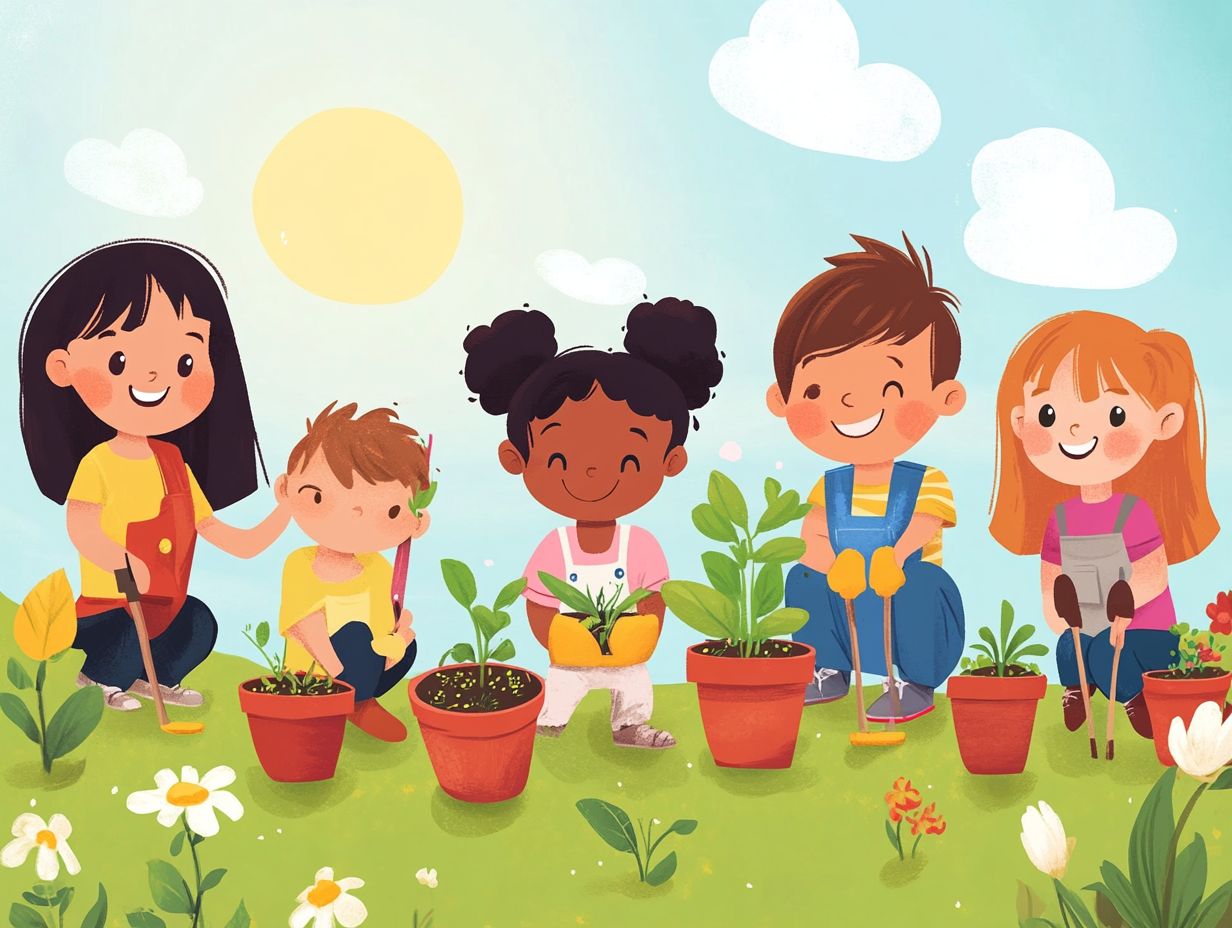
- Planting a garden teaches kids about responsibility, patience, and the importance of reducing food waste.
- Upcycling household items is a fun and creative way to reduce waste and encourage resourcefulness in kids.
- Nature walks help kids appreciate and connect with the environment, promoting a sense of responsibility towards sustainability.
1. Plant a Garden
Planting a garden not only nurtures sustainability but also offers a valuable opportunity to teach children about caring for the environment, the variety of life around them, and the essential connection to the natural world. These lessons are vital for cultivating future generations of people who care for the environment.
When you engage kids in hands-on gardening projects, they learn the science behind plant growth. They also develop a genuine appreciation for native species that attract beneficial insects like bees and butterflies. Creating bee habitats fosters meaningful discussions about the role of pollinators in our ecosystems, highlighting the crucial link between healthy environments and food production.
Participating in community gardening initiatives instills a strong sense of collaboration. Children work alongside peers and adults, sharing knowledge and embracing a collective responsibility for our planet. Through these enriching experiences, they can emerge as passionate protectors of nature, discovering how even a small garden can make a remarkable impact on their local ecosystem.
2. Upcycle Household Items
Upcycling household items presents a creative opportunity for you to reduce waste and embrace a zero-waste lifestyle. This showcases sustainable practices that children can actively engage in to foster their sense of environmental responsibility.
You can enjoy upcycling projects as a family, transforming old clothes into stylish bags or unique accessories that allow everyone to express their artistic flair. Why not explore crafting eye-catching decorative items from various recycled materials? For example, turn glass jars into beautiful candle holders!
Get excited! These fun projects spark creativity in kids while providing a meaningful backdrop for discussions about pollution, the urgency of conservation, and the importance of reusing resources. By coming together in these endeavors, you can ignite a passion for sustainability in your children, making environmental stewardship a shared value that resonates within your family.
3. Go on a Nature Walk
Embarking on a nature walk offers your family an immersive experience that deepens your connection with local wildlife and the environment. It invites you to observe and document your discoveries through nature journaling or nature photography.
As you navigate through diverse ecosystems ranging from lush forests to tranquil wetlands you can engage in enriching activities like identifying plants and animals, honing valuable skills that enhance your understanding of biodiversity.
This hands-on exploration not only sparks curiosity but also allows you to appreciate the variety of life and the captivating stories unfolding within these habitats. Such experiences become powerful educational tools, instilling a sense of responsibility for conservation while sharpening your observational skills.
Nature walks evolve into memorable journeys where imagination intertwines with education, laying the foundation for aspiring naturalists. Start these activities today and watch your kids thrive in their love for the planet!
4. Create a Composting System
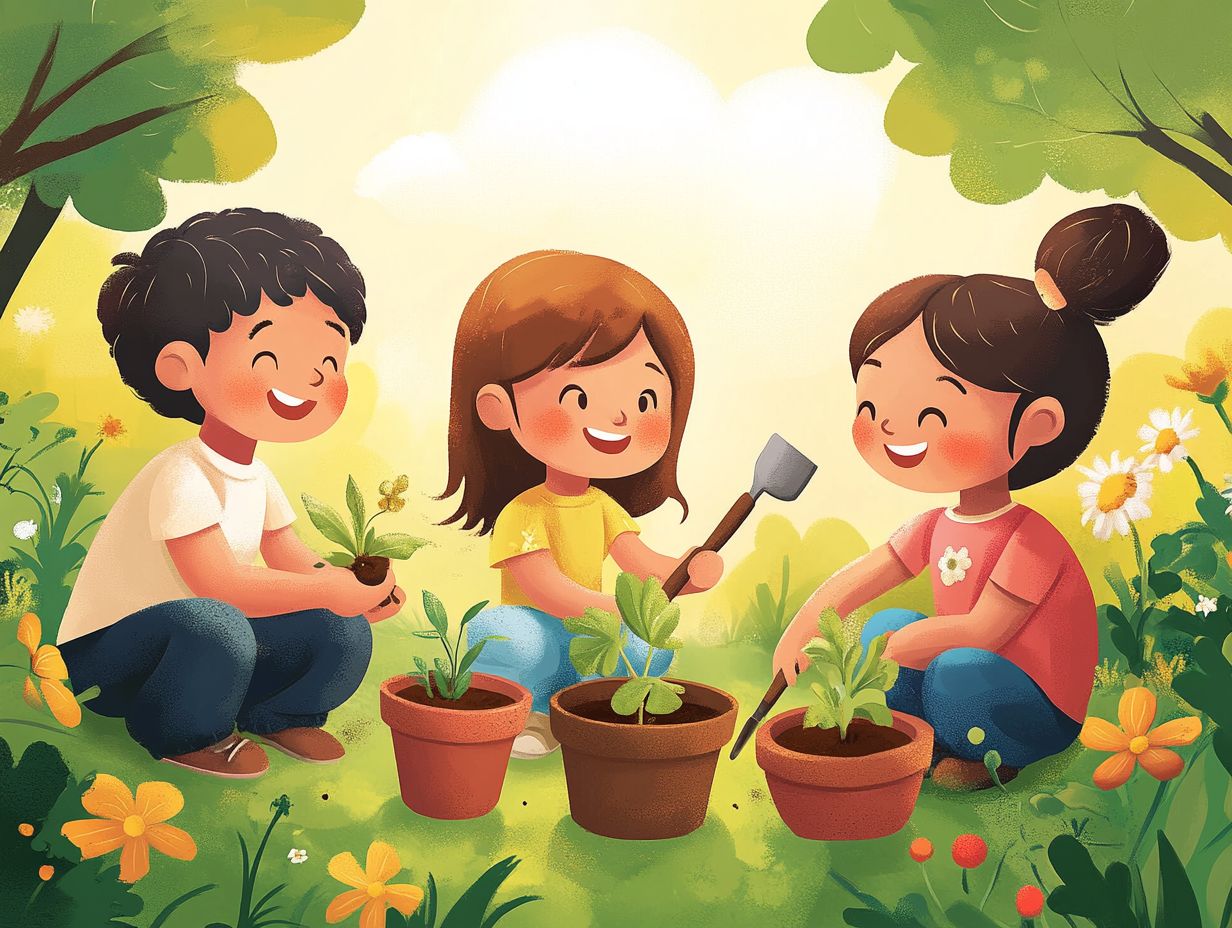
Creating a composting system is a brilliant way to reduce waste while teaching your children about environmental responsibility and sustainable practices that benefit your community.
By starting this eco-friendly project, you can take meaningful steps towards minimizing the waste you produce and fostering a healthier planet. Practices such as water conservation and energy efficiency are great ways to contribute.
To set up your compost bin, first choose an ideal location preferably a shaded area in your yard. Decide whether you want a compost tumbler (a container that helps mix organic waste easily) or a simple pile method.
Gather the right materials: kitchen scraps like veggie peels, eggshells, and coffee grounds, along with yard waste such as leaves and grass clippings. These organic materials will turn into nutrient-rich soil and attract beneficial microorganisms and insects, helping to create a robust ecosystem.
This practice reduces landfill waste and enriches your garden soil, leading to healthier plants and a thriving environment.
5. Participate in a Beach or Park Cleanup
Participating in a beach or park cleanup allows you to take an active role in the fight against pollution and climate change. This nurtures a sense of environmental stewardship and the importance of being a responsible global citizen.
These hands-on experiences educate you about the intricate relationships within ecosystems. They also deepen your appreciation for the natural world and the importance of caring for it.
When communities unite for cleanup events, you enhance the beauty of your surroundings and convey a powerful message about collective responsibility in addressing climate change.
Organizing these initiatives can be simple:
- Choose a location,
- Rally volunteers through social media, and
- Provide essential supplies like gloves and trash bags.
The broader implications of these actions extend beyond immediate results. They cultivate sustainable habits and inspire you to advocate for policy changes that prioritize environmental health.
Your efforts illustrate the vital role individuals play in creating lasting positive impacts on their local environments.
Why Is It Important to Teach Kids About Sustainability?
Teaching kids about sustainability is essential for nurturing a future generation equipped with critical thinking skills and eco-friendly habits. This knowledge helps them tackle urgent global challenges like climate change and pollution.
By integrating sustainability education into school curriculums, you enable young minds to engage meaningfully with their surroundings. When students dive into hands-on projects like creating community gardens, making seed bombs, or conducting local waste audits they gain valuable insights about ecological systems.
Educational discussions encourage them to think critically about their choices and their impact on the planet. This combination ignites a sense of responsibility and fosters lasting connections with nature.
Ultimately, this shapes informed global citizens committed to a sustainable future.
What Are Some Other Ways to Encourage Sustainable Habits in Kids?
Encouraging sustainable habits in kids can be an enriching journey. This can be achieved through a variety of creative practices and activities that promote environmental responsibility while keeping the learning experience enjoyable.
For example, hosting a clothing swap not only refreshes their wardrobes but also teaches them the value of reusing and recycling. Imagine the excitement as they discover new favorites!
Building solar ovens allows kids to experiment with renewable energy. What a thrilling way to connect with nature and enjoy a delightful snack!
These fun activities spark creativity and excitement, instilling a sense of responsibility toward the planet and shaping their values for a more sustainable future.
How Can Parents Incorporate Sustainability into Everyday Activities?
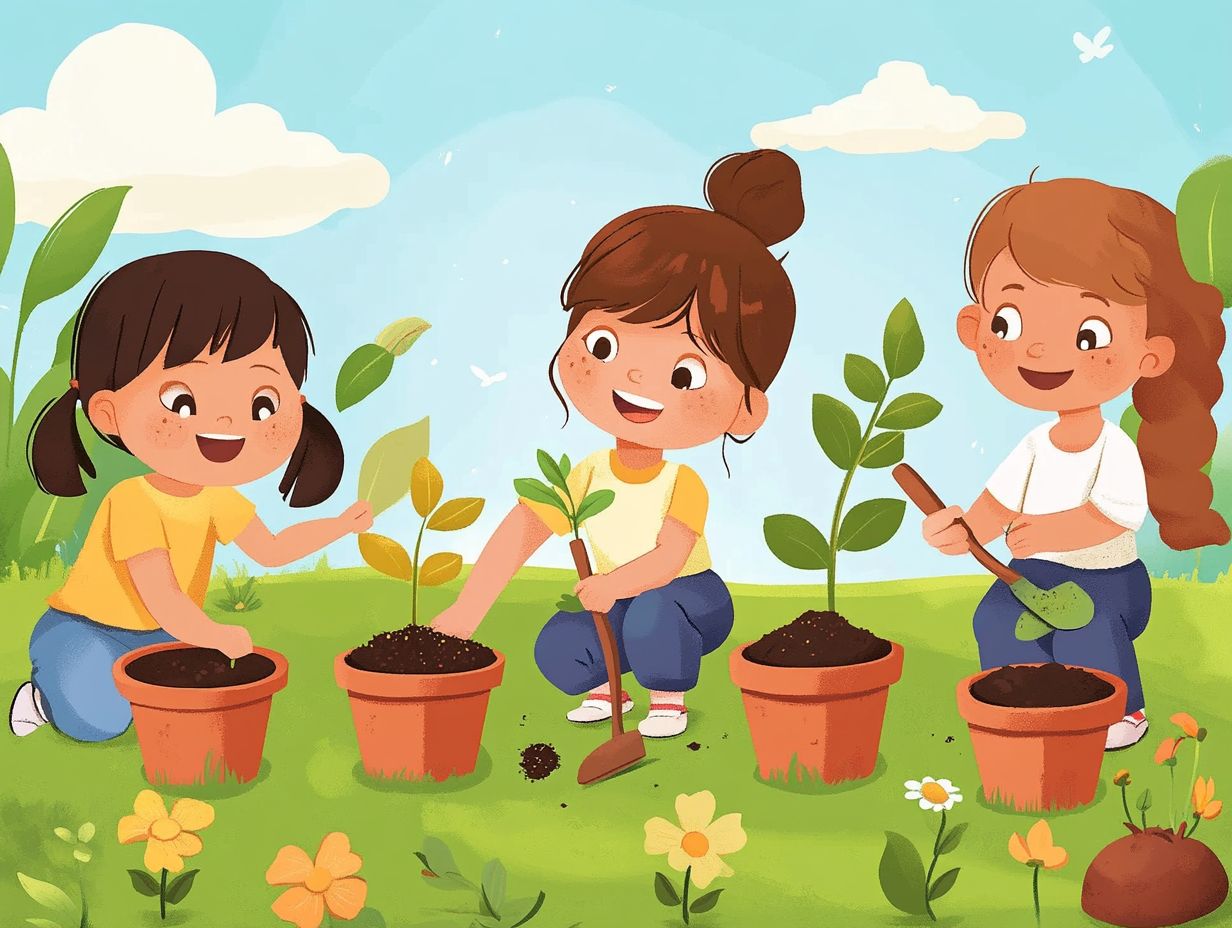
Weave sustainability easily into your daily life by adopting practical approaches like sustainable transportation, green cleaning, water conservation, and energy efficiency.
Use reusable bags for shopping. This reduces plastic waste and sets a powerful example for your children in the fight against pollution and climate change. Conducting energy audits assessments of your home s energy use can help you identify areas for improvement. This enhances your home’s efficiency while teaching your kids the importance of conservation.
Engage your children in exciting projects, like building water filtration systems, to ignite their curiosity about environmental science and the significance of clean resources. By modeling these eco-friendly habits and participating in eco-conscious outdoor activities, you instill a sense of responsibility in them, fostering a deeper appreciation for nature and sustainability from an early age.
What Are the Long-Term Benefits of Teaching Kids About Sustainability?
Teaching kids about sustainability provides invaluable long-term benefits. It transforms them into environmental stewards who champion sustainable practices and nurture a healthier planet for future generations.
By embedding sustainability in their early education, children grasp concepts like ecological balance, resource conservation, and biodiversity’s vital role. As they appreciate their environment, they develop critical thinking skills to tackle complex ecological issues with confidence.
This strong foundation shapes their choices and turns them into leaders ready to inspire change in their communities. Their dedication to eco-friendly practices can potentially spur others to act, creating a ripple effect that highlights the urgency of climate action and equips an entire generation to confront climate change’s challenges head-on.
How Can Schools and Communities Promote Sustainability Education for Kids?
Schools and communities significantly influence sustainability education for children by integrating environmental science into the curriculum and encouraging participation in events like Earth Day.
These collaborative efforts often extend beyond classroom walls, engaging local organizations committed to environmental preservation. For example, students can participate in hands-on projects, such as creating bee habitats, which bolster biodiversity while imparting valuable lessons about ecology and the role of pollinators.
Organizing environmental documentaries provides another avenue for students to explore pressing issues while honing their critical thinking and teamwork skills. Through these initiatives, the partnership between schools and community groups ignites a passion for sustainability, helping students understand their role in fostering a healthier planet.
What Are Some Fun and Creative Ways to Teach Kids About Sustainability?
Explore fun and creative methods to teach kids about sustainability. Incorporate hands-on activities that inspire a sense of environmental responsibility and foster eco-friendly habits through engaging projects.
For example, nature journaling can spark their creativity as they observe and document the wonders around them, deepening their connection to the environment. Building solar ovens not only offers a delightful science experiment but also teaches them about renewable energy through practical experience. Engaging in environmental storytelling allows kids to express their thoughts on nature conservation, weaving narratives that emphasize their responsibilities toward the planet.
These activities captivate their imaginations and instill a lifelong commitment to protecting the world they inhabit.
Frequently Asked Questions
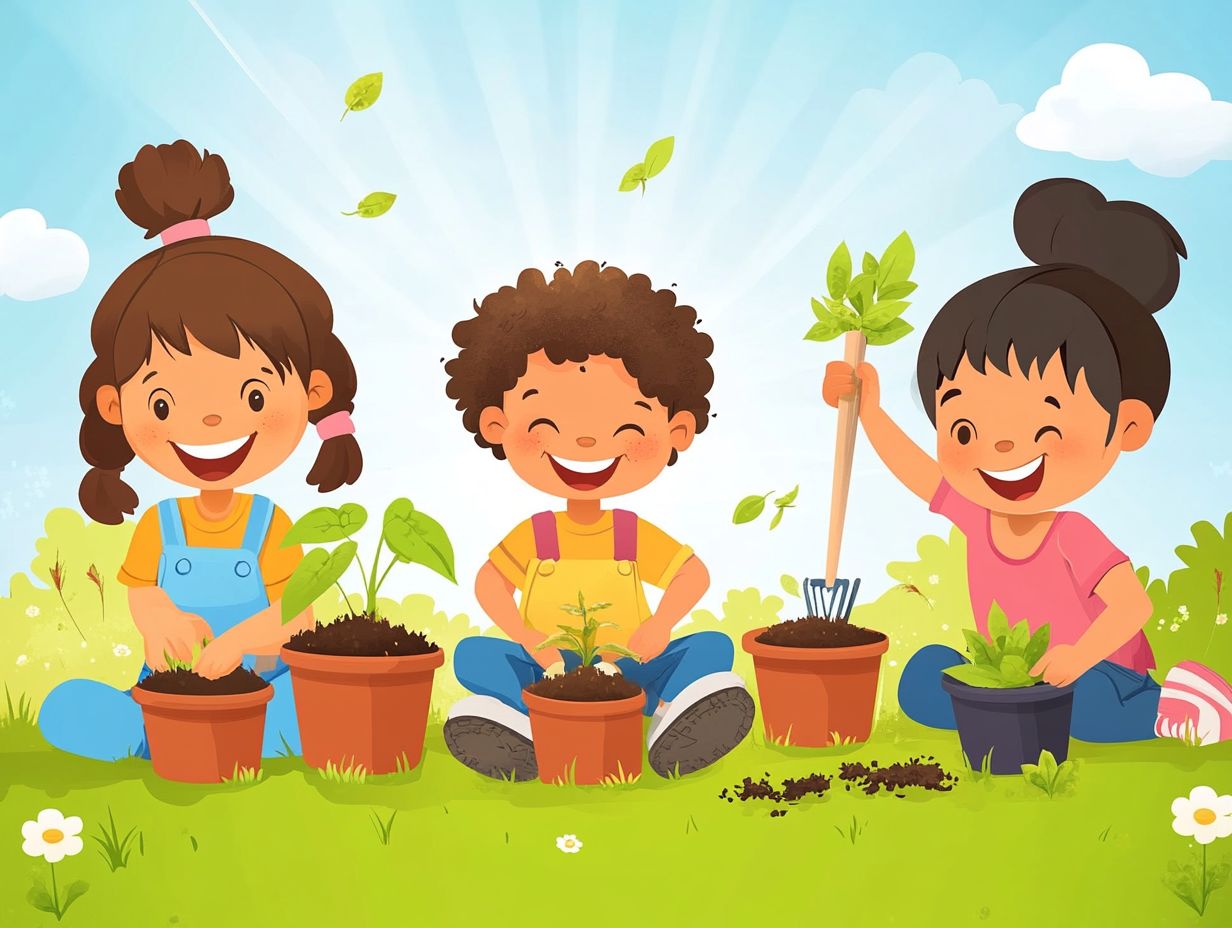
What are some fun activities to get kids interested in sustainability?
- Plant a garden together. Kids can learn about the importance of growing their own food and how it impacts the environment.
- Create a recycling game. Make sorting and recycling fun by turning it into a game with prizes.
- Go on a nature scavenger hunt. This is a great way to get kids outdoors and learning about different plants and animals.
- Make eco-friendly crafts. Use recycled materials to create fun and useful items like bird feeders or tote bags.
- Have a green movie night. Watch documentaries or movies about sustainability and discuss them afterwards.
How can I teach my kids about conserving energy?
- Check how much energy we use at home. Have kids go around the house and find areas where energy is wasted.
- Make a DIY solar oven. This hands-on activity teaches kids about alternative energy sources.
- Let s make saving energy exciting by unplugging devices when we re done!
- Try having a no-lights hour. Turn off all lights and have a candlelit dinner to see how much energy we can conserve.
- Go on a bike ride. This fun activity teaches kids about alternative transportation and conserves energy!
What are some ways to reduce waste with kids?
- Make a compost bin! Teach kids about composting and how it helps reduce food waste.
- Have a clothing swap. Encourage kids to donate clothes they no longer wear to reduce textile waste.
- Make your own cleaning products. This teaches kids about using natural, non-toxic ingredients and reduces plastic waste from store-bought cleaners.
- Use reusable containers. Pack lunches and snacks in reusable containers instead of plastic bags.
- Organize a neighborhood cleanup. Get kids involved in picking up litter in their community.
Why is it important to involve kids in sustainability efforts?
- They are the future. Teaching kids about sustainability ensures a greener future for our planet.
- They are influential. Kids can spread the message of sustainability to their friends and family.
- They have a fresh perspective. Kids often come up with creative solutions and ideas for sustainability.
- They learn valuable skills. Involving kids in sustainability activities teaches them problem-solving, critical thinking, and teamwork.
- It instills responsibility. By involving kids in sustainability efforts, we teach them to take responsibility for their actions and their environmental impact.
Are there any virtual activities to engage kids in sustainability?
- Take kids on virtual field trips. Explore a recycling facility or a sustainable farm together!
- Play online games. There are many fun games and apps that teach kids about sustainability.
- Sign up for virtual workshops. Focus on sustainability topics like renewable energy or reducing waste.
- Join eco-friendly cooking classes. Learn how to cook sustainable and plant-based meals online.
- Enjoy virtual nature walks. Many national parks offer virtual tours for kids to learn about the environment.
How can I make sustainability fun and engaging for kids?
- Incorporate art! Kids can express their ideas and feelings about sustainability through art projects.
- Use storytelling. Create stories or role-playing games that teach kids about sustainability.
- Have a family challenge. Set a sustainability challenge for the whole family and reward the winners.
- Share success stories. Show kids the positive impact of sustainability by sharing success stories from around the world.
- Celebrate Earth Day! Make Earth Day a fun event with activities like a trash clean-up or a picnic in a park.

